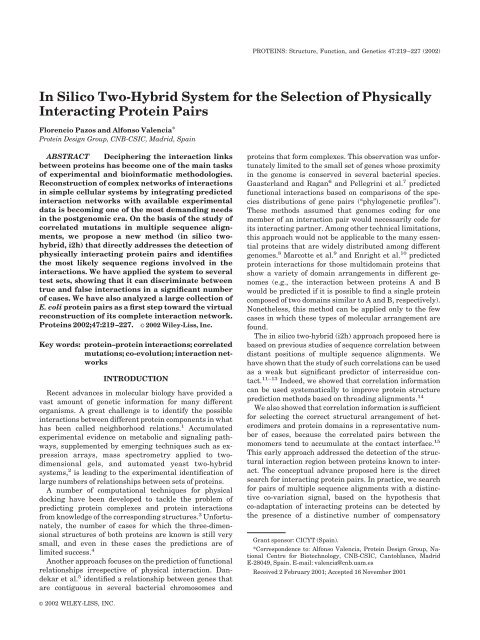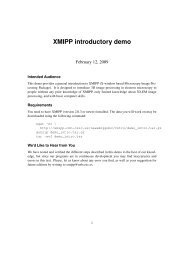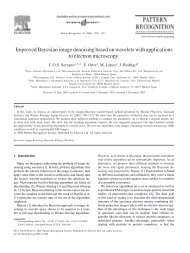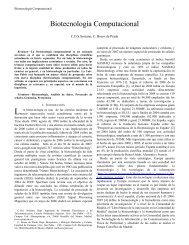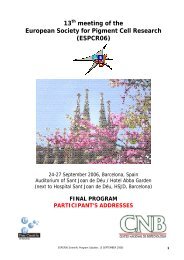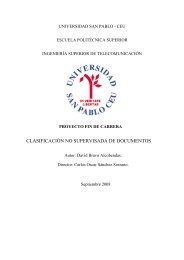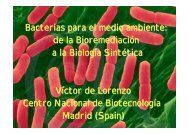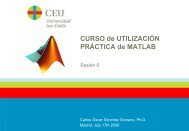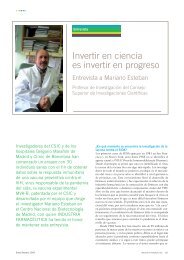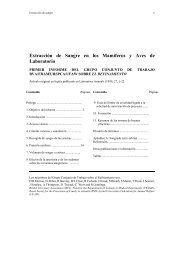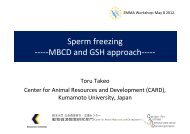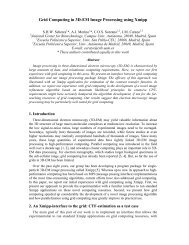In Silico Two-Hybrid System for the Selection of Physically ...
In Silico Two-Hybrid System for the Selection of Physically ...
In Silico Two-Hybrid System for the Selection of Physically ...
You also want an ePaper? Increase the reach of your titles
YUMPU automatically turns print PDFs into web optimized ePapers that Google loves.
PROTEINS: Structure, Function, and Genetics 47:219–227 (2002)<strong>In</strong><strong>Silico</strong><strong>Two</strong>-<strong>Hybrid</strong><strong>System</strong><strong>for</strong><strong>the</strong><strong>Selection</strong><strong>of</strong><strong>Physically</strong><strong>In</strong>teractingProteinPairsFlorencioPazosandAlfonsoValencia*ProteinDesignGroup,CNB-CSIC,Madrid,SpainABSTRACT Deciphering <strong>the</strong> interaction linksbetween proteins has become one <strong>of</strong> <strong>the</strong> main tasks<strong>of</strong> experimental and bioin<strong>for</strong>matic methodologies.Reconstruction<strong>of</strong>complexnetworks<strong>of</strong>interactionsin simple cellular systems by integrating predictedinteraction networks with available experimentaldata is becoming one <strong>of</strong> <strong>the</strong> most demanding needsin <strong>the</strong> postgenomic era. On <strong>the</strong> basis <strong>of</strong> <strong>the</strong> study <strong>of</strong>correlated mutations in multiple sequence alignments,we propose a new method (in silico twohybrid,i2h) that directly addresses <strong>the</strong> detection <strong>of</strong>physically interacting protein pairs and identifies<strong>the</strong> most likely sequence regions involved in <strong>the</strong>interactions. We have applied <strong>the</strong> system to severaltest sets, showing that it can discriminate betweentrue and false interactions in asignificant number<strong>of</strong> cases. We have also analyzed alarge collection <strong>of</strong>E.coliproteinpairsasafirststeptoward<strong>the</strong>virtualreconstruction <strong>of</strong> its complete interaction network.Proteins2002;47:219–227. ©2002Wiley-Liss,<strong>In</strong>c.Key words: protein–proteininteractions;correlatedmutations;co-evolution;interactionnetworksINTRODUCTIONRecent advances in molecular biology have provided avast amount <strong>of</strong> genetic in<strong>for</strong>mation <strong>for</strong> many differentorganisms. Agreat challenge is to identify <strong>the</strong> possibleinteractionsbetweendifferentproteincomponentsinwhathas been called neighborhood relations. 1 Accumulatedexperimental evidence on metabolic and signaling pathways,supplemented by emerging techniques such as expressionarrays, mass spectrometry applied to twodimensionalgels, and automated yeast two-hybridsystems, 2 isleading to <strong>the</strong> experimental identification <strong>of</strong>largenumbers<strong>of</strong>relationshipsbetweensets<strong>of</strong>proteins.A number <strong>of</strong> computational techniques <strong>for</strong> physicaldocking have been developed to tackle <strong>the</strong> problem <strong>of</strong>predicting protein complexes and protein interactionsfromknowledge<strong>of</strong><strong>the</strong>correspondingstructures. 3 Un<strong>for</strong>tunately,<strong>the</strong> number <strong>of</strong> cases <strong>for</strong> which <strong>the</strong> three-dimensionalstructures <strong>of</strong> both proteins are known is still verysmall, and even in <strong>the</strong>se cases <strong>the</strong> predictions are <strong>of</strong>limitedsuccess. 4Ano<strong>the</strong>rapproachfocuseson<strong>the</strong>prediction<strong>of</strong>functionalrelationships irrespective <strong>of</strong> physical interaction. Dandekaret al. 5 identified arelationship between genes thatare contiguous in several bacterial chromosomes andproteinsthat<strong>for</strong>mcomplexes.Thisobservationwasun<strong>for</strong>tunatelylimited to <strong>the</strong> small set <strong>of</strong> genes whose proximityin <strong>the</strong> genome is conserved in several bacterial species.Gaasterland and Ragan 6 and Pellegrini et al. 7 predictedfunctional interactions based on comparisons <strong>of</strong> <strong>the</strong> speciesdistributions <strong>of</strong> gene pairs (“phylogenetic pr<strong>of</strong>iles”).These methods assumed that genomes coding <strong>for</strong> onemember <strong>of</strong> an interaction pair would necessarily code <strong>for</strong>itsinteractingpartner.Amongo<strong>the</strong>rtechnicallimitations,this approach would not be applicable to <strong>the</strong> many essentialproteins that are widely distributed among differentgenomes. 8 Marcotte et al. 9 and Enright et al. 10 predictedprotein interactions <strong>for</strong> those multidomain proteins thatshow avariety <strong>of</strong> domain arrangements in different genomes(e.g., <strong>the</strong> interaction between proteins A and Bwould be predicted if it is possible to find asingle proteincomposed<strong>of</strong>twodomainssimilartoAandB,respectively).None<strong>the</strong>less, this method can be applied only to <strong>the</strong> fewcases in which <strong>the</strong>se types <strong>of</strong> molecular arrangement arefound.The in silico two-hybrid (i2h) approach proposed here isbased on previous studies <strong>of</strong> sequence correlation betweendistant positions <strong>of</strong> multiple sequence alignments. Wehaveshownthat<strong>the</strong>study<strong>of</strong>suchcorrelationscanbeusedas aweak but significant predictor <strong>of</strong> interresidue contact.11–13 <strong>In</strong>deed, we showed that correlation in<strong>for</strong>mationcan be used systematically to improve protein structurepredictionmethodsbasedonthreadingalignments. 14Wealsoshowedthatcorrelationin<strong>for</strong>mationissufficient<strong>for</strong> selecting <strong>the</strong> correct structural arrangement <strong>of</strong> heterodimersand protein domains in arepresentative number<strong>of</strong> cases, because <strong>the</strong> correlated pairs between <strong>the</strong>monomers tend to accumulate at <strong>the</strong> contact interface. 15This early approach addressed <strong>the</strong> detection <strong>of</strong> <strong>the</strong> structuralinteraction region between proteins known to interact.The conceptual advance proposed here is <strong>the</strong> directsearch <strong>for</strong> interacting protein pairs. <strong>In</strong> practice, we search<strong>for</strong> pairs <strong>of</strong> multiple sequence alignments with adistinctiveco-variation signal, based on <strong>the</strong> hypo<strong>the</strong>sis thatco-adaptation <strong>of</strong> interacting proteins can be detected by<strong>the</strong> presence <strong>of</strong> a distinctive number <strong>of</strong> compensatoryGrantsponsor:CICYT(Spain).*Correspondence to: Alfonso Valencia, Protein Design Group, NationalCentre <strong>for</strong> Biotechnology, CNB-CSIC, Cantoblanco, MadridE-28049,Spain.E-mail:valencia@cnb.uam.esReceived2February2001;Accepted16November2001Published online 00 Month 2001 in Wiley <strong>In</strong>terScience(www.interscience.wiley.com). DOI:10.1002/prot.10074©2002 WILEY-LISS, INC.
220 F. PAZOS AND A. VALENCIAmutations in <strong>the</strong> corresponding proteins <strong>of</strong> different species.MATERIALS AND METHODSCalculation <strong>of</strong> Correlation ValuesCorrelated mutations evaluate <strong>the</strong> similarity in variationpatterns between positions in a multiple sequencealignment. The similarity <strong>of</strong> those variation patterns isthought to be related to compensatory mutations. Thebasic method <strong>for</strong> calculating correlated mutations wasoriginally proposed by Göbel et al. 11 A position-specificmatrix is calculated <strong>for</strong> each position in <strong>the</strong> sequence; thismatrix contains <strong>the</strong> distances, defined as in McLachlan, 16between <strong>the</strong> residues corresponding to all sequence combinationsat that position. The position-specific matrices arecompared with a correlation <strong>for</strong>mula. <strong>In</strong> <strong>the</strong> i2h system, weobtained <strong>the</strong> best results with a variation <strong>of</strong> <strong>the</strong> method inwhich <strong>the</strong> correlation <strong>for</strong>mula was replaced by a rankcorrelation calculation, 17 in which <strong>the</strong> numerical valuesare replaced by <strong>the</strong>ir ordinal ranking number. The rankcorrelation coefficient (r ij ) between positions i and j isgiven byr ij k,l S ikl S i S jkl S j k, jS ikl S i 2k,lS jkl S j 2where <strong>the</strong> summations run <strong>for</strong> every possible pair <strong>of</strong>proteins k and l in <strong>the</strong> multiple sequence alignment. S ikl is<strong>the</strong> ranked similarity between residue i in protein k andresidue i in protein l. S jkl is <strong>the</strong> same <strong>for</strong> residue j.S i and S jare <strong>the</strong> means <strong>of</strong> S ikl and S jkl , respectively.Protein Alignment and Distribution <strong>of</strong>Correlation ValuesOriginal multiple sequence alignments were obtained bysearching <strong>for</strong> homologous proteins with BLAST 18 andaligning <strong>the</strong>m with Clustalw 19 in <strong>the</strong> E. coli test sets, ortaken from <strong>the</strong> HSSP database 20 in <strong>the</strong> cases <strong>of</strong> <strong>the</strong>structural domains and <strong>the</strong> interacting proteins <strong>of</strong> knownstructure (see “test sets” below).Starting with <strong>the</strong> multiple sequence alignments <strong>of</strong> <strong>the</strong>two proteins, we reduce <strong>the</strong>m, leaving only sequences <strong>of</strong>coincident species. The entries in <strong>the</strong> position-specificmatrices <strong>of</strong> <strong>the</strong> positions <strong>of</strong> <strong>the</strong> two proteins are thuscomparable, and calculation <strong>of</strong> interprotein correlatedmutations can be per<strong>for</strong>med by using compatible proteinsequences. This step is easy to visualize by imagining that<strong>the</strong> corresponding sequences <strong>of</strong> <strong>the</strong> same species in eachone <strong>of</strong> <strong>the</strong> two proteins are linked in a “virtual concatenatedalignment” (Fig. 1). If we have more than onehomologous protein in <strong>the</strong> same species (paralogs), wechoose that closest to <strong>the</strong> E. coli sequence in <strong>the</strong> E. coli testsets, and that closest to <strong>the</strong> HSSP master in <strong>the</strong> structuraldomains and <strong>the</strong> interacting proteins <strong>of</strong> known structuretest sets.The interaction index is obtained by comparing <strong>the</strong>distribution <strong>of</strong> correlation values that correspond to pairs<strong>of</strong> positions, one from each protein in <strong>the</strong> concatenatedalignment, with <strong>the</strong> distributions corresponding to pairs <strong>of</strong>positions in <strong>the</strong> individual proteins. This normalizationstep is introduced to decrease <strong>the</strong> potential noise producedby <strong>the</strong> presence <strong>of</strong> divergent sequences that could introduceatypical high correlation values in both concatenatedand individual alignments (Fig. 1). Thus, we obtain <strong>the</strong>interaction index score <strong>for</strong> proteins 1 and 2 with <strong>the</strong>following <strong>for</strong>mula.C 12 1.0iincorrP 12iP 11i P 22i iwhere <strong>the</strong> summation runs <strong>for</strong> all correlation bins from aninitial value (incorr; 0.4 in this study) to 1.0. P 12i is <strong>the</strong>percentage <strong>of</strong> interprotein pairs with correlation value inbin i. P 11i and P 22i are <strong>the</strong> same <strong>for</strong> intraprotein pairs(Fig. 1).We also compare <strong>the</strong> interaction indices <strong>of</strong> one proteinwith all its possible partners to evaluate <strong>the</strong> significance <strong>of</strong>each <strong>of</strong> <strong>the</strong> interactions. The comparison is presented in aZ-score.Sets <strong>of</strong> Protein Families <strong>for</strong> Application<strong>of</strong> <strong>the</strong> i2h <strong>System</strong>The i2h system was applied to various test sets. <strong>In</strong> each<strong>of</strong> <strong>the</strong>m, all possible protein pairs were explored (<strong>for</strong> Nproteins, a total <strong>of</strong> Nx(N-1)/2 possible pairs) by building<strong>the</strong> corresponding concatenated alignments. The mainlimitation was that it was not possible to find in all casesenough sequences after <strong>the</strong> alignment reduction step (see“obtaining <strong>the</strong> alignments”). <strong>In</strong> <strong>the</strong> current application, wefixed a minimal threshold <strong>of</strong> 11 sequences <strong>for</strong> each <strong>of</strong> <strong>the</strong>two proteins from <strong>the</strong> same species. Under <strong>the</strong>se conditions,<strong>the</strong> number <strong>of</strong> protein pairs <strong>for</strong> which it was possibleto per<strong>for</strong>m <strong>the</strong> i2h calculation was considerably lower than<strong>the</strong> total number <strong>of</strong> possible pairs.The first set was composed <strong>of</strong> structural domains ra<strong>the</strong>rthan <strong>of</strong> proteins. We took 14 two-domain proteins with atight intradomain interaction from Pazos et al. 15 The PDBcodes <strong>of</strong> <strong>the</strong> proteins are 4mt2, 3dfr, 4tnc, 1rnd, 4mts,3pgk, 1alc, 3blm, 2pf2, 3adk, 9pap, 2c2c, 3trx, and 1sgt.Calculations were made <strong>for</strong> 133 domain pairs.The second set was started with 53 proteins analyzed byDandekar et al., 5 which <strong>for</strong>m 31 known interactions. Thetotal number <strong>of</strong> possible pairs was 1378, <strong>of</strong> which we couldexplore a reasonable fraction <strong>of</strong> 244 protein pairs byconcatenating sequences extracted from 14 completelysequenced genomes, namely, M. tuberculosis, N. Gonorrhoeae,E. coli, H. pylori, Synechocystis sp., M. <strong>the</strong>rmoautotrophicum,A. aeolicus, B. burgdorferi, P. horikoshii, T.pallidum, B. subtilis, M. jannaschii, H. influenzae, and A.fulgidus. Among those 244 pairs, 8 pairs corresponded towell-documented interactions, and some o<strong>the</strong>r pairs couldbe considered candidates <strong>for</strong> possible interactions, includingdifferent ribosomal proteins.A third set contains 195 pairs with 15 possible interactions,derived from <strong>the</strong> 749 predicted interactions reportedby Marcotte et al. 9 after selecting sequences from correspondingspecies as described above. The Marcotte set wasderived by selecting pairs <strong>of</strong> E. coli proteins that are fusedinto a single protein in different organisms, which in many
IN SILICO TWO-HYBRID SYSTEM 221Fig. 1. Schematic representation <strong>of</strong> <strong>the</strong> i2h method. A: Family alignments are collected <strong>for</strong> two differentproteins, 1 and 2, including corresponding sequences from different species (a, b, c, …). B: A virtual alignmentis constructed, concatenating <strong>the</strong> sequences <strong>of</strong> <strong>the</strong> probable orthologous sequences <strong>of</strong> <strong>the</strong> two proteins.Correlated mutations are calculated as described in Materials and Methods. C: The distributions <strong>of</strong> <strong>the</strong>correlation values are recorded. We used 10 correlation levels. The corresponding distributions arerepresented <strong>for</strong> <strong>the</strong> pairs <strong>of</strong> residues internal to <strong>the</strong> two proteins (P11 and P22) and <strong>for</strong> <strong>the</strong> pairs composed <strong>of</strong>one residue from each <strong>of</strong> <strong>the</strong> two proteins (P12). The interaction index is calculated from <strong>the</strong>se distributions(see Materials and Methods).cases implies a functional relationship between <strong>the</strong> proteins,but not necessarily a direct physical interaction. 9 <strong>In</strong>most cases, nei<strong>the</strong>r <strong>the</strong> functional nor <strong>the</strong> physical interactionshave been verified experimentally.The fourth test set was composed <strong>of</strong> interacting proteins<strong>of</strong> known structure. The interacting chains were extractedfrom <strong>the</strong> SPIN database (http://trantor.bioc.columbia.edu/cgi-bin/SPIN/), which contains all <strong>the</strong> protein complexescontained in <strong>the</strong> PDB Protein Data Bank. 21 By using <strong>the</strong>SPIN search engine, it is possible to search <strong>the</strong> set <strong>of</strong>protein complexes <strong>for</strong> specific characteristics. We searchedin its sequence-unique set, excluding homodimers andcomplexes involving proteases. This was done to eliminatestrong peculiar signals. We also excluded chains involvedin more than one interaction in an attempt to limit <strong>the</strong> setto heterodimers. The set was <strong>the</strong>n filtered by using <strong>the</strong>SCOP 22 structural classification to eliminate <strong>the</strong> chainslabeled as “membrane peptides,” “small proteins,” and“coiled coils.” This filtering resulted in 226 interactingprotein chains (113 interactions). <strong>In</strong> this case, we need 12sequences from common species <strong>for</strong> a pair to be evaluated.From <strong>the</strong> final list <strong>of</strong> 25,425 possible pairs, we excludedthose with sequence identity 40%. With those restrictionswe could make calculations <strong>for</strong> 321 pairs, 17 <strong>of</strong> whichare known to interact.The fifth protein set was <strong>for</strong>med <strong>of</strong> a collection <strong>of</strong> 67,238pairs corresponding to E. coli proteins that fulfill <strong>the</strong>requirements <strong>for</strong> number <strong>of</strong> sequences in <strong>the</strong> concatenatedalignments as <strong>for</strong> <strong>the</strong> previous E. coli sets, representing asmall fraction <strong>of</strong> <strong>the</strong> possible pairs <strong>for</strong>med by all E. coliproteins. Even if this set represents only a fraction <strong>of</strong> allpossible proteins, it contains on average 300 pairs <strong>for</strong>each protein, adding relevance to <strong>the</strong> Z-score calculationassociated to <strong>the</strong> interaction indices. The correspondingdatabase entries and alignments can be found in http://pdg.cnb.uam.es/i2h.These data sets include all pairs <strong>for</strong> which it waspossible to obtain a sufficient number <strong>of</strong> sequences <strong>for</strong> <strong>the</strong>alignments. They do not correspond to any selection bias.RESULTSTo test <strong>the</strong> quality <strong>of</strong> <strong>the</strong> i2h predictions, we firstanalyzed a previously derived set <strong>of</strong> two domain proteins <strong>of</strong>known three-dimensional structure. A large collection <strong>of</strong>
222 F. PAZOS AND A. VALENCIATABLE I. List <strong>of</strong> Pairs in <strong>the</strong> Structural Domains Data SetPair <strong>In</strong>teraction index Pair <strong>In</strong>teraction index2c2c_2-1alc_1 3.503 3adk_2-4nc_2 0.9611sgt_2-4mt2_1 3.448 1alc_1-1md_2 0.9579pap_1-9pap_2* 3.042 1sgt_1-2c2c_2 0.8891alc_1-1alc_2* 2.852 2c2c_2-3pgk_1 0.8782c2c_1-4mt2_1 2.825 3trx_1-9pap_2 0.8574tms_1-4tms_2* 2.735 4tnc_1-4mt2_2 0.8533trx_1-3trx_2* 2.571 4tnc_2-4mt2_2 0.8364mt2_1-4mt2_2* 2.469 3trx_1-3pgk_2 0.8292c2c_2-4mt2_1 2.355 3trx_1-9pap_1 0.8142c2c_2-4mt2_2 2.331 2c2c_2-1rnd_2 0.8134tnc_1-4tnc_2* 2.238 4tms_2-3dfr_2 0.8093blm_1-3blm_2* 2.206 9pap_2-3adk_2 0.8053pgk_1-3pgk_2* 2.197 4tms_1-3dfr_2 0.8042c2c_1-4mt2_2 2.139 1sgt_2-1alc_1 0.7991sgt_2-2c2c_1 2.068 9pap_1-3adk_2 0.7902c2c_1-1alc_1 2.011 3trx_2-9pap_2 0.7612c2c_1-1alc_2 1.886 4tnc_2-4mt2_1 0.7473adk_1-3adk_2* 1.862 3adk_2-3pgk_2 0.7261sgt_2-2c2c_2 1.835 4tnc_1-4mt2_1 0.7182c2c_1-2c2c_2* 1.787 9pap_2-4tnc_2 0.7023adk_1-3pgk_1 1.624 3trx_1-3adk_1 0.6731rnd_1-4mt2_1 1.530 3dfr_1-3dfr_2* 0.6572c2c_1-9pap_2 1.520 2pf2_2-1alc_2 0.6283adk_2-3dfr_2 1.507 3adk_1-4tnc_1 0.6171sgt_2-2pf2_2 1.489 3adk_1-4tnc_2 0.6149pap_1-3adk_1 1.488 2pf2_2-1alc_1 0.5953adk_1-3pgk_2 1.444 3adk_2-4tnc_1 0.5392c2c_2-1alc_2 1.415 4tms_1-3dfr_1 0.5072c2c_1-3pgk_2 1.389 3trx_2-3pgk_1 0.4891sgt_1-4mt2_1 1.387 3trx_2-3pgk_2 0.4713adk_1-3dfr_1 1.367 3trx_1-3adk_2 0.4711rnd_2-4mt2_1 1.359 1sgt_1-1alc_1 0.4552c2c_2-3adk_1 1.319 3trx_1-2c2c_2 0.4531rnd_1-1rnd_2* 1.314 3trx_1-2c2c_1 0.4463pgk_1-4tms_1 1.299 4tms_2-4tnc_2 0.4442c2c_1-3adk_1 1.297 2c2c_1-1rnd_2 0.4423pgk_1-4tms_2 1.292 1sgt_2-1alc_2 0.4353trx_1-3pgk_1 1.279 3trx_2-3adk_1 0.4272c2c_1-3pgk_1 1.278 4tms_1-4tnc_2 0.4131alc_1-4mt2_1 1.278 1sgt_1-1rnd_1 0.4032c2c_2-9pap_2 1.274 4tms_1-4tnc_1 0.4011rnd_1-4mt2_2 1.258 4tms_2-3dfr_1 0.3983adk_2-3pgk_1 1.252 1alc_2-4mt2_2 0.3621rnd_2-4mt2_2 1.240 1sgt_1-1rnd_2 0.3583adk_1-3dfr_2 1.209 1sgt_1-4mt2_2 0.3563trx_2-2c2c_1 1.196 1sgt_2-1rnd_1 0.3523pgk_2-4tms_2 1.178 3trx_1-4tnc_2 0.3163pgk_2-4tms_1 1.170 2c2c_1-4tnc_1 0.3033adk_2-3dfr_1 1.136 4tms_2-4tnc_1 0.2993trx_2-9pap_1 1.133 9pap_2-4tnc_1 0.2891sgt_1-1sgt_2* 1.113 1sgt_1-1alc_2 0.2781sgt_1-2pf2_2 1.098 9pap_1-4tnc_2 0.2542c2c_2-9pap_1 1.094 2c2c_1-4tnc_2 0.2362c2c_1-3adk_2 1.067 3trx_1-4tnc_1 0.2331sgt_2-4mt2_2 1.063 1sgt_2-1rnd_2 0.2293trx_2-2c2c_2 1.058 1alc_1-4mt2_2 0.2272c2c_2-3pgk_2 1.047 2c2c_2-4tnc_2 0.2181alc_2-4mt2_1 1.037 3pgk_1-4tnc_1 0.2021alc_2-1rnd_1 1.033 3pgk_1-4tnc_2 0.1992c2c_1-1rnd_1 1.029 9pap_1-4tnc_1 0.1869pap_2-3adk_1 1.014 2c2c_2-4tnc_1 0.1742c2c_2-3adk_2 1.008 3trx_2-3adk_2 0.1612c2c_2-1rnd_1 1.004 3pgk_2-4tnc_1 0.1501alc_2-1rnd_2 1.003 3pgk_2-4tnc_2 0.1271sgt_1-2c2c_1 0.991 3trx_2-4tnc_1 0.1032c2c_1-9pap_1 0.977 3trx_2-4tnc_2 0.0701alc_1-1rnd_1 0.968*List <strong>of</strong> possible pairs in <strong>the</strong> structural domains data set (Fig. 2), with corresponding interactionindex values. Pairs are labeled “pdbid1_domain1_pdbid2_domain2.” The pairs corresponding toknown interactions are in bold. The table is sorted by interaction index value.
IN SILICO TWO-HYBRID SYSTEM 223Fig. 2. Results obtained in a set <strong>of</strong> two domain proteins <strong>of</strong> knownstructure. The i2h method was applied to <strong>the</strong> set <strong>of</strong> 14 proteins with two“interacting” domains, previously used <strong>for</strong> <strong>the</strong> prediction interactionregions. 15 A: The interaction index is represented <strong>for</strong> <strong>the</strong> 133 pairs with 11or more sequences in common. The true positive hits are highlighted withfilled squares. B: Representation <strong>of</strong> i2h results, reminiscent <strong>of</strong> thoseobtained in <strong>the</strong> experimental yeast two-hybrid system. The diameter <strong>of</strong> <strong>the</strong>black circles is proportional to <strong>the</strong> interaction index; true pairs arehighlighted with gray squares. Empty spaces correspond to those casesin which <strong>the</strong> i2h system could not be applied, because <strong>the</strong>y contained 11sequences from different species in common <strong>for</strong> <strong>the</strong> two domains.possible domain pairs was prepared by treating differentdomains as independent proteins. <strong>In</strong> most cases, <strong>the</strong> i2hsystem scored <strong>the</strong> correct pair <strong>of</strong> protein domains above allo<strong>the</strong>r possible interactions (Table I, Fig. 2). Most <strong>of</strong> <strong>the</strong>false positives involve <strong>the</strong> domains <strong>of</strong> two proteins. One <strong>of</strong><strong>the</strong>m is a metallothionein (pdb code: 4mt2), a Cys-richprotein predicted to interact with many o<strong>the</strong>r domains asstrongly as with its own second domain. We have noexplanation <strong>for</strong> this behavior, which may be related toartifacts in <strong>the</strong> multiple sequence alignment produced by<strong>the</strong> peculiar sequence composition <strong>of</strong> this protein. Theo<strong>the</strong>r false positive is cytochrome-C2 (2c2c). The result <strong>for</strong>this well-characterized set <strong>of</strong> proteins can be used as anindication <strong>of</strong> <strong>the</strong> relationship between score and quality <strong>of</strong>prediction. Scores 1.5 can be considered as an initialindication <strong>of</strong> interaction; scores 2.0 correspond mostly totrue interactions.Remember that i2h analysis is based on <strong>the</strong> prediction <strong>of</strong>physical proximity between residue pairs and, toge<strong>the</strong>rwith <strong>the</strong> predictions <strong>of</strong> interactions between proteins, it ispossible to recover directly <strong>the</strong> predicted interacting residues.15 <strong>In</strong> <strong>the</strong> case <strong>of</strong> <strong>the</strong> hemoglobin / dimmer, <strong>for</strong>example, <strong>the</strong> strongest interaction predictions were found<strong>for</strong> residues 37, 52, 88, and 84 in <strong>the</strong> -subunit and 102, 57,46, and 64 in <strong>the</strong> -subunit. Toge<strong>the</strong>r with a set <strong>of</strong>conserved residues, <strong>the</strong>se <strong>for</strong>m part <strong>of</strong> <strong>the</strong> interactionsurface <strong>of</strong> <strong>the</strong> two subunits (data not shown). This observationadds value to <strong>the</strong> i2h predictions because <strong>the</strong>y includenot only <strong>the</strong> possible protein partners but also <strong>the</strong> prediction<strong>of</strong> <strong>the</strong>ir possible region <strong>of</strong> interaction.A second test set was derived from that used by Dandekaret al. 5 to select those proteins <strong>for</strong> which we couldobtain enough sequences in at least 11 genomes from atotal <strong>of</strong> 14 used to build <strong>the</strong> alignments (see Materials andMethods). This set included 8 known pairs <strong>of</strong> interactionsburied in 244 possible protein pairs. Figure 3 shows thatseven <strong>of</strong> <strong>the</strong> known interactions were found among <strong>the</strong>high scoring pairs in i2h analysis. <strong>In</strong> addition, 11 proteinpairs with a high interaction index were possible interactingproteins, including different ribosomal proteins andtranslation factors. Only one pair <strong>of</strong> known interactingproteins, SecD-SecF, gave a relatively low score. It is <strong>of</strong>interest that, although <strong>the</strong> interaction index <strong>of</strong> this pair islow in absolute terms, it is among <strong>the</strong> best <strong>for</strong> <strong>the</strong> pairs<strong>for</strong>med by SecD with o<strong>the</strong>r potential partners, indicating<strong>the</strong> possibility <strong>of</strong> detecting interactions based on comparison<strong>of</strong> <strong>the</strong>ir indices when <strong>the</strong> absolute score is insufficientlyhigh.We examined <strong>the</strong> influence <strong>of</strong> <strong>the</strong> species distributions on<strong>the</strong>se results, that is, if <strong>the</strong> presence or absence <strong>of</strong> sequences<strong>of</strong> given species could always be related with high (or low)scores. The results are shown in Figure 3(c). There is noobvious relation between <strong>the</strong> species distribution (“phylogeneticpr<strong>of</strong>ile”) and <strong>the</strong> interaction index <strong>for</strong> pairs whosealignment <strong>of</strong> common species contains that distribution.Most <strong>of</strong> <strong>the</strong> phylogenetic pr<strong>of</strong>iles produce a complete range <strong>of</strong>scores, from low to high. There are only a few exceptions [e.g.,<strong>the</strong> phylogenetic pr<strong>of</strong>ile “11011111101111” (<strong>the</strong> alignment<strong>of</strong> common species contains all <strong>the</strong> 14 species but <strong>the</strong> onesfrom N. Gonorrhoeae and T. Pallidum)] that seem to berelated always with low scores.We analyzed a third set <strong>of</strong> protein interactions derivedfrom <strong>the</strong> study by Marcotte et al. 9 The results using <strong>the</strong> i2hsystem revealed an interesting complementation with <strong>the</strong>approach <strong>of</strong> Marcotte et al. This is not surprising, because<strong>the</strong> i2h system is based on <strong>the</strong> prediction <strong>of</strong> physicalinteractions, and Marcotte’s method addresses <strong>the</strong> prediction<strong>of</strong> general functional relations. From <strong>the</strong>ir protein setwe extracted 195 pairs <strong>of</strong> proteins that contained enoughsequences <strong>for</strong> application <strong>of</strong> i2h analysis, including 15 <strong>of</strong><strong>the</strong> interactions predicted by Marcotte et al. Three were
224 F. PAZOS AND A. VALENCIAstrongly predicted as physically interacting pairs by <strong>the</strong>i2h system, with absolute scores 2.0; two o<strong>the</strong>r pairswere found in <strong>the</strong> range <strong>of</strong> significant predictions (scores 1.5). Among those pairs predicted by both systems, wefound, <strong>for</strong> example, thioredoxin with Thr-rRNA synthaseand Mo c<strong>of</strong>actor biosyn<strong>the</strong>sis protein C with Mo C<strong>of</strong>actorbiosyn<strong>the</strong>sis protein A. For 10 o<strong>the</strong>r cases, i2h predictionsdid not agree with Marcotte’s predictions. For example,<strong>the</strong> interaction predicted by Marcotte et al. between ahypo<strong>the</strong>tical protein similar to ferredoxin reductase andthioredoxin may be due to <strong>the</strong>ir functional relation as part<strong>of</strong> <strong>the</strong> redox-related reactions ra<strong>the</strong>r than <strong>the</strong> physicalinteraction required by <strong>the</strong> i2h analysis. The i2h systempredicts additional interactions between proteins in thatset, including seven pairs with scores 2.0. Even if someare false positives, it is difficult to disregard <strong>the</strong>m completely(e.g., certain interactions between ribosomal proteinsand aminoacyl-tRNA syn<strong>the</strong>tases).The results <strong>for</strong> <strong>the</strong> set <strong>of</strong> interacting proteins <strong>of</strong> knownstructure extracted from <strong>the</strong> SPIN database are shown inFigure 4. Again, most <strong>of</strong> <strong>the</strong> pairs <strong>of</strong> interacting chains plotat high scores. Among <strong>the</strong> false positives we find, <strong>for</strong>example, <strong>the</strong> pair <strong>for</strong>med by 1aisA with 1volB (two TATAbinding proteins), many pairs among hemoglobins, 1lgbC-1hdsA (N2 fragment <strong>of</strong> lactotransferrin with hemoglobin),and 1cpcB-1phnA (two phycocyanins). Among <strong>the</strong> falsenegatives we find 1ttpB-1ttpA (subunits <strong>of</strong> <strong>the</strong> tryptophansynthase), 1aqdA-1aqdB (two chains <strong>of</strong> <strong>the</strong> Hla-Dr1 classII histocompatibility complex), and 1outA-1outB (- and-chains <strong>of</strong> trout hemoglobin).Finally, we applied <strong>the</strong> i2h system to a large collection <strong>of</strong>E. coli proteins to show <strong>the</strong> feasibility <strong>of</strong> <strong>the</strong> systematicreconstruction <strong>of</strong> interaction networks in full genomes. <strong>In</strong>its current state, <strong>the</strong> database contains 67,238 pairs, <strong>for</strong>which we found at least 11 homologous sequences <strong>of</strong>common species <strong>for</strong> <strong>the</strong> two proteins in each pair. Theextension <strong>of</strong> this experiment will require enlargement <strong>of</strong><strong>the</strong> corresponding alignments, increasing <strong>the</strong> number <strong>of</strong>protein pairs and thus <strong>the</strong> number <strong>of</strong> potential interactioncandidates. The number <strong>of</strong> predicted interactions at differentinteraction index cut<strong>of</strong>fs is shown in Figure 5.Despite <strong>the</strong> limited size <strong>of</strong> <strong>the</strong> experiment, interestingrelationships were found among <strong>the</strong> high scoring pairs,Fig. 3. Results obtained in <strong>the</strong> Dandekar data set. The i2h methodwas applied to <strong>the</strong> set <strong>of</strong> bacterial interacting proteins analyzed byDandekar et al., 5 using multiple sequence alignments compiled from 14fully sequenced genomes. A: The interaction index is represented <strong>for</strong> <strong>the</strong>244 possible pairs as in Figure 2(a). <strong>In</strong> this case, possible interactions areindicated with empty squares, including different ribosomal proteins andelongation factors. B: Representation <strong>of</strong> i2h results reminiscent <strong>of</strong> <strong>the</strong>typical representation <strong>of</strong> yeast two-hybrid experimental data. <strong>In</strong> this case,a subset <strong>of</strong> <strong>the</strong> results <strong>of</strong> (A) is represented, corresponding to proteins that<strong>for</strong>m part <strong>of</strong> protein pairs with experimentally verified interactions andprotein families with enough alignments. As in Figure 2(b), <strong>the</strong> diameter <strong>of</strong><strong>the</strong> black circles is proportional to <strong>the</strong> interaction index, positive cases arehighlighted with dark gray squares, and plausible interactions with lightgray squares. Empty spaces correspond to those cases with 11sequences from different species in common, as in Figure 2. C: Values <strong>of</strong>interaction indexes <strong>for</strong> <strong>the</strong> different phylogenetic pr<strong>of</strong>iles in this data set. Aphylogenetic pr<strong>of</strong>ile represents <strong>the</strong> pattern <strong>of</strong> presence (1)/absence (0) <strong>of</strong>that species in <strong>the</strong> alignment <strong>of</strong> common species <strong>for</strong> a pair <strong>of</strong> proteins.Abbreviations <strong>for</strong> <strong>the</strong> names <strong>of</strong> <strong>the</strong> species are shown at <strong>the</strong> right. Thevalues <strong>of</strong> interaction indexes <strong>for</strong> all pairs <strong>of</strong> proteins containing a givenphylogenetic pr<strong>of</strong>ile are drawn.
IN SILICO TWO-HYBRID SYSTEM 225Fig. 4. Results obtained with <strong>the</strong> set <strong>of</strong> interacting proteins <strong>of</strong> known structure. Results <strong>of</strong> <strong>the</strong> application <strong>of</strong><strong>the</strong> i2h method to <strong>the</strong> set <strong>of</strong> interacting proteins <strong>of</strong> known structures extracted from <strong>the</strong> SPIN database (seeMaterials and Methods). The interaction index is represented <strong>for</strong> <strong>the</strong> 321 pairs calculated. The black squarescorrespond to <strong>the</strong> 17 real complexes.to interact with different iron and zinc transporters.Fur<strong>the</strong>r analysis revealed that this hypo<strong>the</strong>tical proteincontains a possible transmembrane region, as well asdistant similarity to an iron transporter from S. marcescens.Both observations added credibility to its possiblefunction as part <strong>of</strong> a metal transport system (Fig. 6).DISCUSSIONFig. 5. Number <strong>of</strong> predicted interactions <strong>for</strong> E. coli. The bars represent<strong>the</strong> number <strong>of</strong> predicted interactions obtained from <strong>the</strong> 67,238 calculatedpairs, depending on <strong>the</strong> interaction index cut<strong>of</strong>f established as a limit toconsider interaction. The y axis scale is logarithmic.corresponding in many cases to known interacting proteinssuch as membrane transporters implicated in spermidine/putrescinetransport (PotB-PotH), transcription factors<strong>of</strong> <strong>the</strong> bacterial two-component system (ArcA-TorR),and <strong>the</strong> two iso<strong>for</strong>ms (N and O) <strong>of</strong> <strong>for</strong>mate dehydrogenase.O<strong>the</strong>r interesting interactions were predicted, includingdifferent hypo<strong>the</strong>tical proteins <strong>for</strong> which <strong>the</strong> possiblerelationships could be a first clue to <strong>the</strong>ir function. Forexample, YABK_ECOLI (Swissprot ID code) was predictedThe application <strong>of</strong> i2h analysis to different sets <strong>of</strong>interactions revealed a considerable capacity <strong>for</strong> detection<strong>of</strong> true interactions with distinct scores. The in<strong>for</strong>mationprovided by <strong>the</strong> i2h systems is an indication not only <strong>of</strong> apossible interaction but also <strong>of</strong> <strong>the</strong> possible protein regioninvolved. The main practical limitation <strong>of</strong> <strong>the</strong> currentapplication <strong>of</strong> <strong>the</strong> i2h system is <strong>the</strong> difficulty in obtaininglarge multiple sequence alignments <strong>of</strong> corresponding sequences<strong>for</strong> each possible pair <strong>of</strong> proteins. This problemmay disappear with <strong>the</strong> incorporation <strong>of</strong> new sequencesfrom <strong>the</strong> continuous stream <strong>of</strong> newly sequenced genomes.Regarding <strong>the</strong> prediction <strong>of</strong> correlated mutations, it waspreviously shown that more in<strong>for</strong>mative alignments led toimproved predictions <strong>of</strong> intraprotein contacts. 12Ano<strong>the</strong>r important limitation, common to <strong>the</strong> o<strong>the</strong>rapproaches <strong>for</strong> <strong>the</strong> prediction <strong>of</strong> protein interaction networks,5,9,10,23 is <strong>the</strong> difficulty in obtaining good test sets toquantify <strong>the</strong> per<strong>for</strong>mances <strong>of</strong> <strong>the</strong> different methods.Current experimental descriptions <strong>of</strong> full interactionnetworks (i.e., systematic applications <strong>of</strong> yeast-2-hybridscreenings) are still far from complete in both number <strong>of</strong>known interactions and reliability. 24 Moreover, knowninteractions are only a small part <strong>of</strong> <strong>the</strong> many stillunknown reactions <strong>of</strong> biological relevance. The development<strong>of</strong> <strong>the</strong> field <strong>of</strong> protein interaction prediction wouldrequire <strong>the</strong> creation <strong>of</strong> gold standards as has occurred in
226 F. PAZOS AND A. VALENCIAFig. 6. Example <strong>of</strong> data analysis using <strong>the</strong> E. coli i2h database. Analysis <strong>of</strong> predicted interaction partners<strong>for</strong> <strong>the</strong> hypo<strong>the</strong>tical protein YABK_ECOLI, one <strong>of</strong> <strong>the</strong> E. coli proteins included in <strong>the</strong> prototype database. Theinteraction index distribution <strong>for</strong> <strong>the</strong> different possible pairs is compared in an interactive Web-based interfacethat facilitates inspection <strong>of</strong> <strong>the</strong>ir functions by following links to <strong>the</strong> in<strong>for</strong>mation deposited in Swissprot 35 ando<strong>the</strong>r databases, localization in <strong>the</strong> E. coli genome, and <strong>the</strong> possible relationship to E. coli operons. <strong>In</strong> this case,<strong>the</strong> different functions highlight <strong>the</strong> relationships <strong>of</strong> <strong>the</strong> hypo<strong>the</strong>tical protein with iron and zinc transportmechanisms, as well as with o<strong>the</strong>r hypo<strong>the</strong>tical proteins. The experimental i2h E. coli database can beaccessed at http://pdg.cnb.uam.es/i2h.fields such as gene finding, threading, and secondarystructure prediction. Ef<strong>for</strong>ts are underway to constructdatabases <strong>of</strong> annotated interactions. For example, DIP 25 :http://dip.doe-mbi.ucla.edu; MIPS: http://www.mips.biochem.mpg.de.Because <strong>of</strong> <strong>the</strong>se difficulties in obtaining good test sets,o<strong>the</strong>r methods have been tested by analyzing <strong>the</strong> presence<strong>of</strong> similar keywords in <strong>the</strong>ir database descriptions 9 or bymanually screening some <strong>of</strong> <strong>the</strong> proposed interactions. 5We used a first test set composed <strong>of</strong> protein domains,because it provides unambiguous in<strong>for</strong>mation about stable,permanent protein interaction. <strong>In</strong> addition, we tested ourmethod with some <strong>of</strong> <strong>the</strong> data sets previously used by o<strong>the</strong>rauthors finding a reasonable level <strong>of</strong> accuracy.The reduction <strong>of</strong> <strong>the</strong> initial multiple sequence alignments,taken only sequences from common species (seeMaterials and Methods), restricts <strong>the</strong> number <strong>of</strong> availablesequence pairs and <strong>the</strong> quality <strong>of</strong> <strong>the</strong> alignments. Wepreviously showed that including a broad range <strong>of</strong> sequencesin <strong>the</strong> alignments improves <strong>the</strong> predictions <strong>of</strong>intraprotein contacts. 12 There<strong>for</strong>e, it is conceivable that<strong>the</strong> implementation <strong>of</strong> a more sophisticated process <strong>for</strong>sequence selection (i.e., selecting putative orthologoussequences) would improve <strong>the</strong> results even if it wouldimply an increase in computational complexity.The results derived from <strong>the</strong> i2h system may also beimproved by increasing <strong>the</strong> accuracy <strong>of</strong> <strong>the</strong> basic correlationmethod used to detect interaction sites, by re<strong>for</strong>mulating<strong>the</strong> current algorithm (see Refs. 26–29 <strong>for</strong> alternativeapproaches) or by combining correlated mutations witho<strong>the</strong>r methods <strong>for</strong> <strong>the</strong> prediction <strong>of</strong> functionally importantresidues. 30–32We aim to apply <strong>the</strong> i2h system to <strong>the</strong> prediction <strong>of</strong>networks <strong>of</strong> physical interactions in complete genomes toprovide suggestions about protein interactions and <strong>the</strong>irbiological function. The large set <strong>of</strong> interactions <strong>for</strong> <strong>the</strong> E.
IN SILICO TWO-HYBRID SYSTEM 227coli genome here presented could be considered a first stepin this direction. The experience <strong>of</strong> Marcotte et al., 23combining <strong>the</strong>oretical and experimental data, provides anexcellent departure <strong>for</strong> <strong>the</strong> inclusion <strong>of</strong> <strong>the</strong> i2h predictions,because it represents a distinct type <strong>of</strong> prediction concernedwith <strong>the</strong> detection <strong>of</strong> physical interactions.ACKNOWLEDGMENTSWe thank A. de Daruvar (Lion Biosciences), J.L. Carrascosa(CNB-CSIC), and K. Harshman (DIO-CNB) <strong>for</strong> criticalreading <strong>of</strong> <strong>the</strong> manuscript and suggestions and members<strong>of</strong> <strong>the</strong> Protein Design Group <strong>for</strong> continuous support.REFERENCES1. Nitschke P, Guerdoux-Jamet P, Chiapello H, Faroux G, Henaut C,Henaut A, Danchin A. <strong>In</strong>digo: a World-Wide-Web review <strong>of</strong>genomes and gene functions. FEMS Microbiol Rev 1998;22:207–227.2. Mendelsohn AR, Brent R. Protein interaction methods—towardan endgame. Science 1999;284:1948–1950.3. Lengauer T, Rarey M. Methods <strong>for</strong> predicting molecular complexesinvolving proteins. Curr Opin Struct Biol 1996;5:402–406.4. Dixon JS. Evaluation <strong>of</strong> <strong>the</strong> CASP2 Docking Section. Proteins1997;S1:198–204.5. Dandekar T, Snel B, Huynen M, Bork P. Conservation <strong>of</strong> geneorder: a fingerprint <strong>of</strong> proteins that physically interact. TrendsBiochem Sci 1998;23:324–328.6. Gaasterland T, Ragan MA. Microbial genescapes: phyletic andfunctional patterns <strong>of</strong> ORF distribution among prokaryotes. MicrobComp Genomics 1998;3:199–217.7. Pellegrini M, Marcotte EM, Thompson MJ, Eisenberg D, YeatesTO. Assigning protein functions by comparative genome analysis:protein phylogenetic pr<strong>of</strong>iles. Proc Natl Acad Sci USA 1999;96:4285–4288.8. Tatusov RL, Koonin EV, Lipman DJ. A genomic perspective <strong>of</strong>protein families. Science 1997;278:631–637.9. Marcotte EM, Pellegrini M, Ho-Leung N, Rice DW, Yeates TO,Eisenberg D. Detecting protein function and Protein–proteininteractions from genome sequences. Science 1999;285:751–753.10. Enright AJ, Iliopoulos I, Kyrpides NC, Ouzounis CA. Proteininteraction maps <strong>for</strong> complete genomes based on gene fusionevents. Nature 1999;402:86–90.11. Göbel U, Sander C, Schneider R, Valencia A. Correlated mutationsand residue contacts in proteins. Proteins 1994;18:309–317.12. Olmea O, Valencia A. Improving contact predictions by <strong>the</strong>combination <strong>of</strong> correlated mutations and o<strong>the</strong>r sources <strong>of</strong> sequencein<strong>for</strong>mation. Fold Design 1997;2:S25–S32.13. Pazos F, Olmea O, Valencia A. A graphical interface <strong>for</strong> correlatedmutations and o<strong>the</strong>r structure prediction methods. Comput ApplBiosci 1997;13:319–321.14. Olmea O, Rost B, Valencia A. Effective use <strong>of</strong> sequence correlationand conservation in fold recognition. J Mol Biol 1999;293:1221–1239.15. Pazos F, Helmer-Citterich M, Ausiello G, Valencia A. Correlatedmutations contain in<strong>for</strong>mation about Protein–protein interaction.J Mol Biol 1997;271:511–523.16. Mclachlan AD. Test <strong>for</strong> comparing related aminoacid sequences. JMol Biol 1971;61:409–424.17. Press WH, Teukolsky SA, Vetterling WT, Flannery BP. Numericalrecipes in C: <strong>the</strong> art <strong>of</strong> scientific computing. Cambridge: CambridgeUniversity Press; 1992.18. Altschul SF, Gish W, Miller W, Myers EW, Lipman DJ. Basic localalignment search tool. J Mol Biol 1990;215:403–410.19. Higgins DG, Bleasby AJ, Fuchs R. CLUSTAL V: improved s<strong>of</strong>tware<strong>for</strong> multiple sequence alignment. Comput Appl Biosci 1992;8:189–191.20. Sander C, Schneider R. The HSSP data base <strong>of</strong> protein structuresequencealignments. Nucleic Acids Res 1993;21:3105–3109.21. Berman HM, Westbrook J, Feng Z, Gilliland G, Bhat TN, WeissigH, Shindyalov IN, Bourne PE. The Protein Data Bank. NucleicAcids Res 2000;28:235–242.22. Murzin AG, Brenner SE, Hubbard T, Chotia C. SCOP: a structuralclassification <strong>of</strong> proteins database <strong>for</strong> <strong>the</strong> investigation <strong>of</strong> sequencesand structures. J Mol Biol 1995;247:536–540.23. Marcotte EM, Pellegrini M, Thompson MJ, Yeates TO, EisenbergD. A combined algorithm <strong>for</strong> genome-wide prediction <strong>of</strong> proteinfunction. Nature 1999;402:83–86.24. Legrain P, Wojcik J, Gauthier JM. Protein–protein interactionmaps: a lead toward cellular functions. Trends Genet 2001;17:346–352.25. Xenarios I, Fernandez E, Salwinski L, Duan XJ, Thompson MJ,Marcotte EM, Eisenberg D. DIP: <strong>the</strong> database <strong>of</strong> interactingproteins: 2001 update. Nucleic Acids Res 2001;29:239–241.26. Altschuh D, Lesk AM, Bloomer AC, Klug A. Correlation <strong>of</strong>coordinated amino acid substitutions with function in virus relatedto tobacco mosaic virus. J Mol Biol 1987;193:693–707.27. Chelvanayagam G, Eggenschwiler A, Knecht L, Gonnet GH,Benner SA. An analysis <strong>of</strong> simultaneous variation in proteinstructures. Protein Eng 1997;10:307–316.28. Pollock DD, Taylor WR, Goldman N. Coevolving protein residues:maximum likelihood identification and relationship to structure. JMol Biol 1999;287:187–198.29. Shindyalov IN, Kolchanov NA, Sander C. Can three-dimensionalcontacts in protein structures be predicted by analysis <strong>of</strong> correlatedmutations. Protein Eng 1994;7:349–358.30. Andrade MA, Casari G, Sander C, Valencia A. Classification <strong>of</strong>protein families and detection <strong>of</strong> <strong>the</strong> determinant residues with animproved self-organizing map. Biol Cybern 1997;76:441–450.31. Casari G, Sander C, Valencia A. A method to predict functionalresidues in proteins. Nat Struct Biol 1995;2:171–178.32. Lichtarge O, Bourne HR, Cohen FE. An evolutionary trace methoddefines binding surfaces common to protein families. J Mol Biol1996;257:342–358.33. Bairoch A, Boeckmann B. The SWISS-PROT protein sequencedata bank. Nucleic Acids Res 1992;20:2019–2022.


